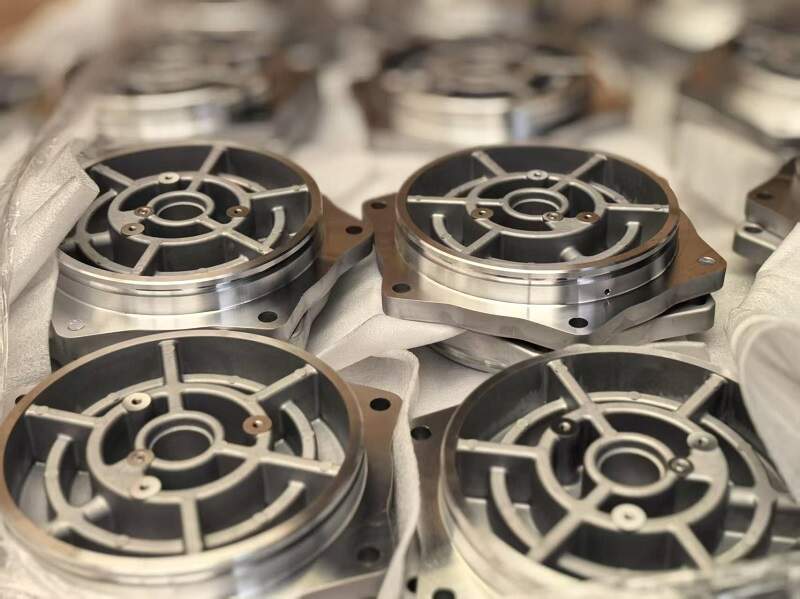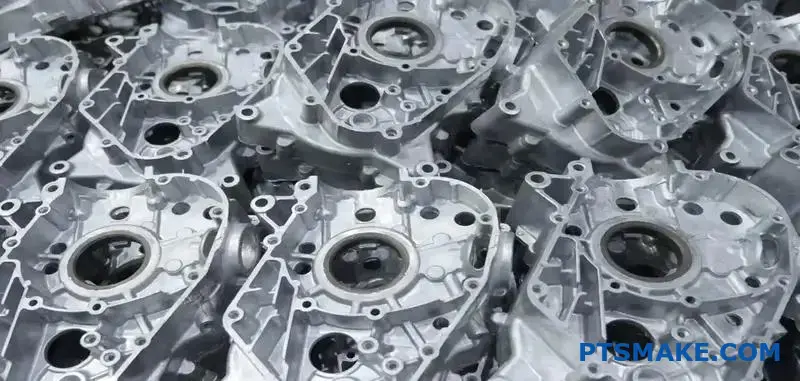Aluminum Casting Company innovations that transform industrial design
Checking Out the Innovative Procedures Behind Modern Aluminum Foundry Workflow
Modern aluminum foundry operations are undergoing significant makeover. Automation and AI are improving production methods, boosting both effectiveness and precision. The combination of 3D printing is enhancing mold and mildew development, while sustainability methods are ending up being a lot more essential. Each of these developments plays a vital duty in redefining the market. The implications of these changes prolong beyond plain manufacturing effectiveness. What chances and difficulties lie ahead for aluminum foundries in this developing landscape?
The Function of Automation in Aluminum Foundries

Additionally, automation adds to improved safety and security requirements within the foundry atmosphere. By transferring harmful tasks to devices, human workers can concentrate on managerial duties and quality assurance, decreasing the threat of mishaps. Furthermore, data analytics originated from automated procedures supply valuable understandings right into functional performance, resulting in better decision-making and continuous renovation. As the need for aluminum items grows, the fostering of automation modern technologies will likely increase, better transforming the landscape of light weight aluminum foundry operations.
Innovations in Casting Technologies
Current innovations in casting innovations are changing light weight aluminum shop operations. Advancements such as 3D printing assimilation, progressed alloy formulations, and automated process optimization are enhancing performance and product high quality. These developments are critical in meeting the advancing needs of the market.
3D Printing Combination
Incorporating 3D printing modern technology right into aluminum foundry procedures has actually changed typical casting methods, boosting both efficiency and accuracy. This innovative method allows for the fast manufacturing of complicated molds and cores, greatly minimizing preparations and product waste. By making use of additive manufacturing, factories can produce elaborate geometries that were previously tough or difficult to accomplish with traditional techniques. The adaptability of 3D printing also makes it possible for fast design modifications, cultivating an extra agile manufacturing procedure. Additionally, this integration supports making use of light-weight frameworks, which is increasingly vital in markets such as auto and aerospace. As light weight aluminum foundries remain to adopt 3D printing, they position themselves at the center of technical innovation, driving improvements in item top quality and operational capabilities.
Advanced Alloy Formulations
The growth of innovative alloy formulations has actually greatly boosted spreading technologies in light weight aluminum foundry operations. These formulations integrate numerous elements, such as magnesium, copper, and silicon, to boost mechanical homes and thermal resistance. By customizing the composition of aluminum alloys, suppliers can accomplish specific performance characteristics that meet the needs of diverse applications, from auto elements to aerospace frameworks. Using innovative alloys likewise adds to decreased weight and raised strength, which are vital consider modern engineering. Furthermore, developments in alloy development make it possible for far better fluidness throughout spreading, causing improved surface coatings and minimized problems. On the whole, progressed alloy formulas represent a significant leap onward, positioning light weight aluminum shops to satisfy the progressing requirements of various sectors successfully.
Automated Process Optimization
Improvements in casting technologies have paved the means for automatic procedure enhancement in aluminum shop procedures. By incorporating advanced software and real-time data analytics, factories can now simplify production processes and enhance quality assurance. Automated systems keep an eye on variables such as air conditioning, stress, and temperature prices, enabling prompt changes that reduce problems and waste. Furthermore, artificial intelligence formulas assess historic performance data to forecast optimal setups, thereby boosting efficiency and reducing cycle times. Robotics additionally play a considerable function, dealing with repeated tasks that boost security and precision. On the whole, these technologies not just drive functional effectiveness however additionally allow factories to fulfill the expanding demand for top notch aluminum elements in numerous markets.
Smart Production and Sector 4.0 Combination
The combination of Smart Production and Market 4.0 within light weight aluminum factories is changing functional effectiveness. By leveraging IoT modern technologies, automation, and robotics, factories can optimize production procedures and decrease downtime. Furthermore, information analytics provides crucial understandings that enhance decision-making and drive constant renovation.
IoT in Shop Procedures
As suppliers progressively embrace the Web of Things (IoT), shop procedures are experiencing a transformative change in the direction of clever production and Market 4.0 integration. Precision aluminum casting. IoT innovations make it possible for real-time information collection and analysis, improving decision-making processes and operational performance. Sensors and connected devices check devices efficiency, material use, and ecological conditions, enabling positive maintenance and resource optimization. This connectivity cultivates a more active production setting, where adjustments can be made quickly in action to market demands. Additionally, IoT promotes improved traceability and top quality control, as data from the entire production cycle can be quickly accessed and examined. Overall, the integration of IoT in shop operations substantially enhances efficiency and drives technology in light weight aluminum production procedures
Automation and Robotics Assimilation
Automation and robotics assimilation is transforming light weight aluminum foundry procedures by improving performance and precision. This transformative technique improves processes such as molding, putting, and completing, decreasing human error and boosting outcome uniformity. By utilizing sophisticated robotic systems, factories can attain higher production prices while maintaining rigorous quality requirements. Automated systems likewise allow real-time monitoring and adaptive control, permitting quick modifications to production specifications. On top of that, the Learn More Here combination of robotics lessens labor prices and alleviates security threats related to hands-on handling of molten steel. As factories embrace wise manufacturing principles integral in Sector 4.0, the synergy between automation and robotics strengthens their competitive edge, leading the means for lasting growth and advancement in the light weight aluminum casting sector.
Data Analytics for Effectiveness
Harnessing information analytics considerably boosts performance within aluminum foundry operations, lining up with clever manufacturing and Industry 4.0 principles. By leveraging real-time information collection and evaluation, shops can monitor production procedures, predict devices failures, and optimize resource allotment. This data-driven strategy facilitates informative decision-making, enabling supervisors to recognize traffic jams and enhance workflow. Additionally, anticipating analytics equips shops to anticipate market needs, consequently lowering waste and making sure timely item delivery. Integration of information analytics with IoT devices boosts operational exposure, promoting a proactive upkeep culture. Eventually, executing these sophisticated analytical strategies not just improves productivity yet also drives innovation, positioning light weight aluminum factories to meet the progressing demands of the market while preserving one-upmanships in a swiftly altering landscape.
Sustainable Practices in Light Weight Aluminum Spreading
While the light weight aluminum casting industry has actually typically faced ecological obstacles, many foundries are now adopting lasting read the full info here methods to minimize their impact (Aluminum Casting Company). A significant emphasis has been on recycling aluminum scrap, which not just decreases waste but also saves power compared to key aluminum manufacturing. Ingenious melting innovations, such as induction heating systems, enhance power efficiency and lower greenhouse gas emissions
Furthermore, shops are applying closed-loop water supply to decrease water usage and decrease thermal contamination. The use of environment-friendly binders in mold-making procedures is acquiring traction, more reducing dangerous exhausts.
In addition, some facilities are investing in renewable resource resources to power procedures, lining up with global sustainability goals. By incorporating these practices, the light weight aluminum spreading market is progressing toward an extra environmentally liable future, showing that economic growth can coexist with environmental stewardship - Aluminum Foundry. These efforts show a commitment to sustainability and the significance of environmental liability in production
Top Quality Control Innovations
As the aluminum casting sector breakthroughs towards sustainability, the significance of quality assurance developments becomes increasingly obvious. Modern light weight aluminum foundries are adopting advanced technologies to improve their quality control processes. Strategies such as real-time monitoring and data analytics allow makers to identify issues and disparities early in the production cycle. Implementing computerized evaluation systems equipped with machine learning algorithms assurances that products fulfill strict top quality standards while lessening human error.
The integration of non-destructive screening techniques, such as ultrasonic and radiographic examinations, gives deeper insights into the honesty of castings without damaging the product. These innovations not only enhance product reliability but likewise decrease waste, lining up with sustainability objectives. On top of that, the fostering of standardized quality structures aids streamline operations across various factories, guaranteeing consistency in outcome. click for info Jointly, these innovations are reshaping quality control, promoting a culture of quality within the light weight aluminum spreading industry.
Future Fads in Aluminum Factory Workflow
What developments lie ahead for light weight aluminum factory operations? The future of aluminum shops is positioned for improvement via innovations in automation, fabricated knowledge, and sustainable practices. The integration of robotics and automated systems is expected to enhance effectiveness and accuracy in the spreading procedures, minimizing human error and labor expenses. In addition, AI-driven analytics will certainly make it possible for real-time monitoring and predictive upkeep, maximizing functional performance and lessening downtime.
Sustainability remains a prime focus, with shops increasingly embracing green methods, such as making use of recycled light weight aluminum and establishing low-emission melting modern technologies. Innovations in 3D printing are additionally anticipated to change mold-making, enabling for complicated geometries and minimized product waste. As the industry welcomes digitalization, data-driven decision-making will certainly end up being essential, allowing shops to respond swiftly to market needs. Jointly, these trends guarantee to redefine light weight aluminum factory procedures, making them much more efficient, sustainable, and versatile to future difficulties.

Regularly Asked Inquiries
What Security Measures Are Carried Out in Aluminum Foundry Workflow?
Aluminum factory procedures apply different safety and security measures, including personal protective tools, air flow systems to manage fumes, regular security training, emergency action strategies, and strict surveillance of temperature level and devices to stop accidents and assurance worker security.
Exactly How Do Factories Manage Labor Force Educating for New Technologies?

What Products Are Commonly Reused in Aluminum Foundries?
Light weight aluminum foundries generally reuse scrap light weight aluminum, including post-consumer products like beverage containers, automobile parts, and building and construction products. This reusing process lowers waste and preserves resources, adding to a much more lasting light weight aluminum production market.
Exactly How Does Light Weight Aluminum Casting Influence the Environment?
Light weight aluminum casting influences the setting through energy-intensive procedures, greenhouse gas emissions, and prospective neighborhood air pollution. Innovations in reusing and lasting techniques can alleviate these results, promoting a much more green strategy to light weight aluminum manufacturing.
What Are the Typical Lead Times for Aluminum Casting Projects?
Typical lead times for light weight aluminum spreading tasks differ substantially, generally varying from two to 6 weeks. Variables influencing these timelines include complexity, order size, and product schedule, affecting general manufacturing routines in factory operations.
Automation increasingly plays an important duty in aluminum shops, enhancing efficiency and precision in the manufacturing process. Advancements in casting technologies have paved the way for computerized procedure improvement in light weight aluminum shop operations. Utilizing data analytics greatly boosts effectiveness within aluminum foundry operations, aligning with clever production and Market 4.0 concepts. A considerable focus has been on reusing light weight aluminum scrap, which not only decreases waste however likewise saves energy contrasted to primary light weight aluminum manufacturing. Aluminum shops generally recycle scrap light weight aluminum, including post-consumer products like drink containers, automobile parts, and construction products.